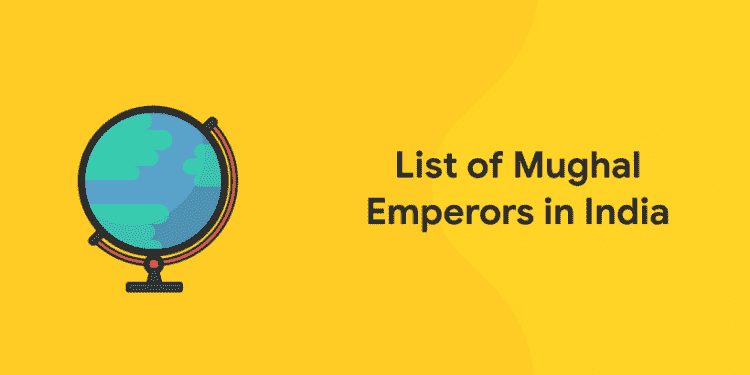India has witnessed the reign of different rulers. Every name in the ruling phase of India has a special connotation. However, the most remarkable phase was the reign of Mughals. There were various Mughal emperors who had left a mark on the history pages of Medieval India. Be it the founder of the Mughal Empire – Babur or his invincible descendants like Humayun, Akbar, Aurangzeb, etc., each name has its own list of glory, achievements and power. In this blog we will discuss about List of Mughal Emperors in India.
The Mughal reign started from 16th century and lasted till the 19th century.
Attempt free GK and current affairs quiz! Download Entri App!
List of Mughal Emperors in India
The list of Mughal emperors who ruled India between 1526 to 1857 is given below:
| Emperor | Reign | Description |
| Babur | 1526–1530 | Was a direct descendant of Genghis Khan through Timur and was the founder of the Mughal Empire after his victories at the Battle of Panipat (1526) and the Battle of Khanwa |
| Humayun | 1530–1540 | Reign interrupted by Suri Dynasty. Being young and inexperienced led him to be regarded as a less effective ruler than Sher Shah Suri, who defeated him and established the Suri Dynasty. |
| Suri Dynasty | 1540-1555 | No Mughal rule |
| Humayun | 1555–1556 | Restored rule was more unified and effective than the initial reign of 1530–1540.He left the unified empire to his son, Akbar. |
| Akbar (was one of the youngest rulers. Became ruler at the age of 13) | 1556–1605 | He and Bairam Khan defeated Hemu during the Second Battle of Panipat and later won famous victories during the Siege of Chittorgarh and the Siege of Ranthambore. One of his most famous construction marvels was the Lahore Fort. He abolished Jizyah tax imposed on Hindus.To know more about Akbar’s successors, check the linked article. |
| Jahangir | 1605–1627 | Opened relations with the British East India Company. |
| Shah Jahan | 1628–1658 | Under him, Mughal art and architecture reached their zenith.He constructed the Taj Mahal, Jama Masjid, Red Fort, Jahangir mausoleum, and Shalimar Gardens in Lahore. Died in the captivity of his son Aurangzeb. |
| Aurangzeb | 1658–1707 | He reinterpreted Islamic law and presented the Fatawa-e-Alamgiri.He captured the diamond mines of the Sultanate of Golconda and spent the major part of his last 27 years in the war with the Maratha rebels and expanded the empire to its greatest extent. |
| Bahadur Shah I (also known as Muazzam/ShahAlam I) | 1707–1712 | After his reign, the empire went into steady decline due to the lack of leadership qualities among his immediate successors. He released Shahuji, Son of Shambuji, who was the elder son of Shivaji. |
| Jahandar Shah | 1712–1713 | Was an unpopular incompetent titular figurehead. |
| Furrukhsiyar | 1713–1719 | His reign marked the ascendancy of the manipulative Syed Brothers, execution of the rebel Banda. In 1717 he granted a Firman to the English East India Company granting them duty-free trading rights for Bengal, the Firman was repudiated by the notable Murshid Quli Khan. |
| Rafi UL-Darjat | 1719 | The 10th Mughal Emperor. He succeeded Furrukhsiyar, being proclaimed Badshah by the Syed Brothers. |
| Rafi Ud-Daulat | 1719 | Was Mughal emperor for a brief period in 1719. |
| MuhammadIbrahim | 1720 | Attempted to seize the throne at the behest of the Syed Brothers in order to depose emperor Muhammad Shah |
| Muhammad Shah (also called Rangeela) | 1719–17201720–1748 | Got rid of the Syed Brothers. Countered the emergence of the renegade Marathas and lost large tracts of the Deccan and Malwa in the process. Suffered the invasion of Nadir-Shah of Persia in 1739. |
| Ahmad Shah Bahadur | 1748–1754 | His Minister Safdarjung was responsible for the Mughal Civil War, during which Mughal forces massacred by the Maratha during the Battle of Sikandarabad |
| Alamgir II | 1754–1759 | He was murdered by a conspiracy of Imad-UL-Mulk and his Maratha associate Sadashivrao Bhau |
| Shah Jahan III | 1759-1760 | He was overthrown after the Third Battle of Panipat by Prince Mirza Jawan Bakht. |
| Shah Alam II | 1760–1806 | He is known to have fought against the British East India Company during the Battle of Buxar and reformed the Mughal Army under the command of Mirza Najaf Khan and is thus known as one of the last effective Mughal Emperors. |
| Akbar Shah II | 1806–1837 | He designated Mir Fateh Ali Khan Talpur as the new Nawab of Sindh. Although he was under British protection his imperial name was removed from the official coinage after a brief dispute with the British East India Company. |
| Bahadur ShahII | 1837–1857 | He was the last Mughal Emperor. He was deposed by the British and exiled to Burma following the Indian Rebellion of 1857. |
Click here for Interesting Facts and Quiz on World Hiroshima Day
Why Practice from Entri?
- Always provides you up to date materials that are created by Entri’s Top Experts.
- Mock tests available in bilingual and other regional languages
- Download Entri to access the unlimited mock test.
Navigating through Entri
- Open your Entri App go to the GK Tab and check the mock tests.
- You can check courses and Mock test for other examinations as well
- Subscribe to our Mock Test and clear your examination with flying colors.
Ace your preparation. That is where Entri comes in. It helps you to prepare effectively for your Exam.












